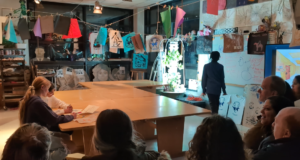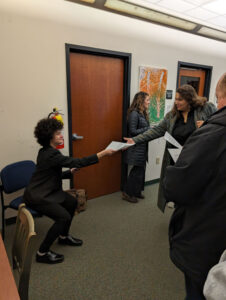What makes a story horrifying? Our deepest fears and anxieties can accelerate our heart rate, making us feel unsafe and unnerved even in familiar, warm places. Do we scream most at jump scares, terrifying monsters and gruesome displays? Or is it about tone, style, mood—and what horrors lurk in one’s everyday life?
“Middle School can be really scary,” explains Maya Kassutto, seventh grade English teacher. Maya had taught a horror unit in English for several years, and even though she doesn’t personally love the genre more than any other, she thinks it meets her students where they are. “Seventh graders run the gauntlet that is Middle School every single day. It kind of makes them experts in the horror genre—and it gives them the ability to turn a critical lens from the stories they read to the world around them.”

Originally built by English teacher Sunshine O’Donnell, the seventh grade horror unit had been structured to guide classes through stories like “The Tell-Tale Heart” and “Lamb to the Slaughter” to teach them about mood, suspense and other literary techniques they would encounter all across the literary landscape. Students really engaged with these stories, and there always seemed to Maya like there was an opportunity for something more. So when the English department received a curricular development grant, Maya and two other Middle School teachers—CJ Miller in theater and Pete Thobaben in art—collaborated on developing a multidisciplinary unit that would take the suspense from the page to the stage.
“First, I took my horror unit and I made it into a social horror unit, specifically with an emphasis on Black horror,” Maya explains. In social horror, suspense and terror are used to highlight and critique real-world social issues, often drawing on themes of racism, discrimination, misogyny and classism to convey important messages. “It reminds us that the monster isn’t just the monster,” she explains. “The monster is also a messenger.”
The students read works of social horror in the classroom, learned about the evolution of Black horror stories, and completed the unit by writing original scenes of social horror. At the same time, other classes began to jump in with collaboration and extensions of that work—CJ led his group toward putting on productions of four of the scenes written in English class, and Pete’s classroom produced artwork and supporting designs for the productions. These efforts culminated in a student-run House of Horrors on Tuesday, January 23, an immersive theater experience that took viewers all over the school to watch these four productions and enjoy short discussions with student critics about their meaning. Each play was written, directed, staged and acted by students, and student tour-guides ferried viewers from station to station, all while providing little behind the scenes facts and nuances to the performances.

“There aren’t really different types of social horror as much as there are different problems they are tackling,” says Jeffrey W. ’29. In a small group, Jeffrey co-authored one of the performed pieces—A Library of Lies—about a group of friends who sneak into a library to find some books, but are stopped by a monster. “The monster guarding the library wanted to keep the kids from reading the books,” he explains, “books that contained people’s vivid thoughts and feelings and opinions.”
The production of Jeffrey’s story fully leaned into the setting and the conflict, with the director staging the play in the Faulkner Library and leveraging the warm library light for ambience. Lily J. ‘29, the critic for A Library of Lies, loved the premise and could immediately see into the social commentary. The reasoning the monster gives for keeping the books hidden, Lily sees, is the same one that people use when banning books.
“Books are typically banned when they have differing opinions from the masses, opinions that go against authority, religion or cultural norms,” Lily writes. “From the printing press that spread Luther’s Bible to today in 2024, books hold a mighty power to spread knowledge, stories and perspectives, causing many to ban certain books so that their beliefs cannot be spread.”
At the end of A Library of Lies, the kids are able to overcome the monster after much turmoil—though only after rejecting their fear and fighting back. (Followed by a darkly humorous song-and-dance number.) In the Seventh Grade House of Horrors, anything is possible.

